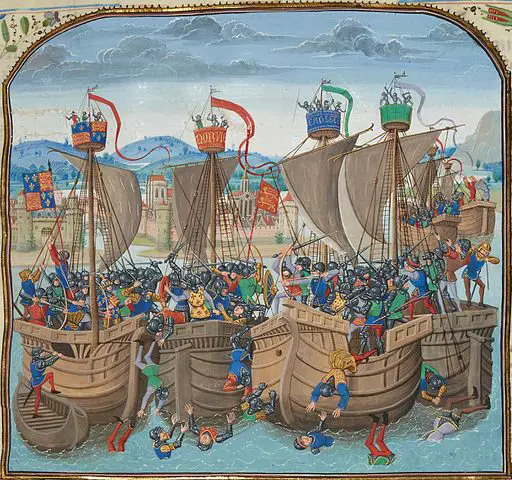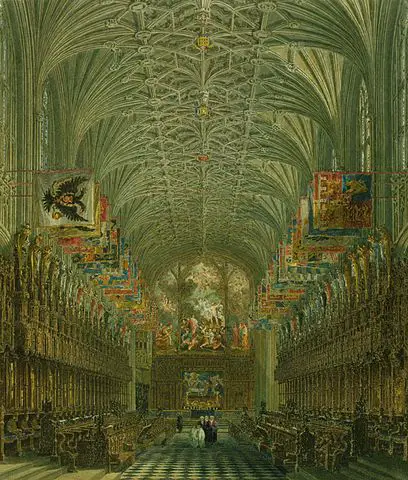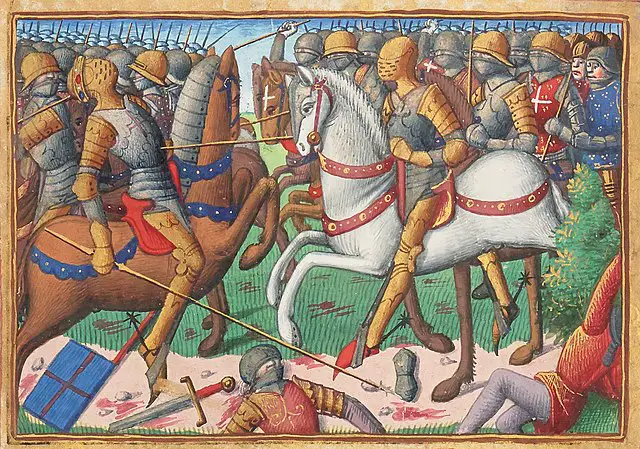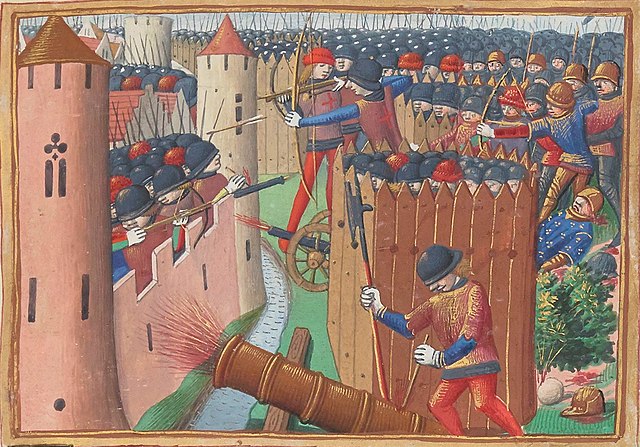
| Time Frame | 24th of May, 1337-19th of October, 1453 |
| Further Reading | How the Fall of Constantinople in 1453 Changed History Forever |
During the 14th and 15th centuries, one of the bloodiest and most important conflicts in human history was erupting across western Europe. Today we call this the “Hundred Years’ War” and by the end of it between 2-3 million people lost their lives. The results of this century-long war ended up transforming the rest of history and in many ways marks the end of the Medieval era.
When historians talk about the hundred years’ war they often cite 3 major ways it changed history.
- The Hundred Years’ War created large group identities and led to the creation of modern nations
- The Hundred Years’ War led to the creation of permanently standing armies in Europe.
- The need for new military technology, specialized units, and strategic tactics caused kingdoms to invest in their people and economy. This effectively ended the medieval era.
When it comes to events in history few are as important as the Hundred Years’ War. Unfortunately, many people are not taught about this massive conflict while in school. Well, here at TheHistoryAce I aim to fix that. If at the end of this article you enjoyed the content then subscribe to the free newsletter and share around.
Without further ado; here are the 3 reasons why the 100 years’ war changed history.
The Hundred Years’ War Created Large Group Identities and Led to the Creation of Modern Nations

One of the major ways in which the Hundred Years’ War forever changed history was by creating large group identities.
Before the Hundred Years’ War, an individual peasant in the English countryside would never have called themselves English. Instead, they would have identified as a member of either a lord’s domain or from an individual village.
However, in the early 14th century European kingdoms started to consolidate their holdings under one lord or king. This king had the power to summon large armies without having to rely upon lower-ranking lords or knights. Now a king could effectively control an entire kingdom easily.
What this means is that an entire kingdom’s power could be summoned up in the name of the ruler. This started to force people to form group identities across large domains. Starting in the early 14th century if you were to walk around the English and French countryside you would hear people saying they identified as part of a larger kingdom.
This is important because without this group identity then it would have been hard for the king to convince large groups of people to fight for him. What we are seeing with the Hundred Years’ War is the creation of the framework for modern nations!
Today when we ask somebody where they are from they will say the nation first and then the region after. The reason that nations started to form in Europe was because of the Hundred Years’ War. As such this new group identity is a major result of the Hundred Years’ War.
The Hundred Years’ War Led to the Creation of Permanently Standing Armies in Europe.

One of the major ways in which the Hundred Years’ War changed history was by creating permanently standing armies in Europe.
Normally when a king in medieval Europe wanted to raise an army for a campaign he would issue an order to his vessels to encourage them to raise an army. In turn, the lords and knights of the realm would show up with their soldiers.
However, at the start of the Hundred Years’ War French King Philip IV issued a general call to arms. This decree was called arrière-ban and it allowed King Philip IV to completely negate the power of his lords and summon forces from across his realm without the aid of any vessels.
This was a major change is it allowed the King of France to summon a huge army at a moment’s notice. Further, it allowed the ruler to direct and pay the army directly. This was a major step towards a permanently standing military to defend a realm. However, after the French military defeat at Poiters in 1356 the arrière-ban was removed.
The next King of France, Charles V, put in place a permanent standing army that would be paid out of the French treasury. This was the first permanent standing western army and was a direct result of the Hundred Years’ War. This standing army was a major contributing factor to the overall success of the French at the end of the war.
Today all modern nations have a standing military. These militaries are used to protect and project a nation’s influence. This trend of having a standing army was created out of the Hundred Years’ War. As a result one of the major ways in which the Hundred Years’ War changed history was by creating the first permanently standing western army.
New Military Technology, Specialized Units, and Strategic Tactics Caused Kingdoms to Invest in Their People and Economy. This Effectively Ended the Medieval Era.

Probably the largest way in which the 100 years’ war changed history was that it forced European kingdoms to invest in their economies and people.
During the medieval era, wars were fought by having more people with weapons than your opponent. Conflicts were a show of force and often just a way for knights to engage their skillset. From 400-1300 AD there was very little advancement in military technology.
This all changed in the mid-14th century. The Black Death came into Europe and began to ravage the population. Now people were becoming scarce so kingdoms had to invest in easier ways to maximize their manpower during a war.
As a result of this, the European kingdoms had to build better armor, tactics, and weapons. From the late 14th century up through the end of the Hundred Years’ War new military technologies such as artillery bombardment, cannons, and mass-produced plate armor became necessary for a successful army to function.
All of this advancement was not cheap and kingdoms began to invest heavily in their economies. Now that a vast majority of manpower was in the military technologies were being developed to help the specialists within medieval society function without aid.
During the Hundred Years’ War, one of the major advances in technology was the blast furnace. This furnace could smelt massive amounts of iron to be used to manufacture cannons. The adoption and use of the blast furnace is just one instance of technology being created to help supply militaries during the Hundred Years’ War
All of this effectively ended the medieval era in Europe. Now all of a sudden the old feudal system of land inheritance and serf ownership started to fade away. Suddenly there were not enough laborers to make feudalism effective in Europe and people started to migrate in massive numbers to cities to pick up the skilled trades.
The Hundred Years’ War was one of the major factors which helped to push the western world from the medieval era into the modern one.
Common Questions About The Hundred Years’ War
While it is impossible to answer all the questions about the Hundred Years’ War as we historians are still finding out more about it every day here are some of the most common.
What Was the Major Cause of the Hundred Years’ War?
There are several main causes of the Hundred Years’ War. However, the main one was a dynastic succession issue of owned lands between the English throne and the French one.
In 1316 French King Louis X died. His daughter, John I, died very young and as such there was a lineage problem within France. Now since the Norman Conquest of England in 1066 technically English lords had a claim to the French Throne and French lords could claim that they held land claims in England.
As you might imagine it was a very complex issue.
In April of 1337 King Philip of France failed to show up for a display of homage to the English throne. Instead, Philip issued a general call to arms and built up a defensive army. This pushed England and France into war.
Who Won the Hundred Years’ War?
The answer is the French, kinda.
The problem is that the Hundred Years’ War lasted from 1337-1453. Initially, the English ended up beating the French and controlling a vast majority of France. However, the costs for the English were massive and they could not sustain their land holdings.
In 1415 the Lancastrian War portion of the Hundred Years’ War started. This bloody conflict saw the French Army drive the English out of France. However, in the end all that happened was that England went back to England and the French regained control over France.
So in the end the war returned previously held French land to France.
Is the Hundred Years’ War the Longest in History?
No, it is up there but it is not the longest.
The longest war in history was the Spanish Reconquista which went from the 8th century AD up until the 15th century. While this war was broken up by several truces and delays in fighting it did last for a very long time.
The Hundred Years’ War is long but it is definitely not the longest.
Summary
There you have it; everything you will ever need to know about how the 100 years’ war changed history.
It really is unfortunate that schools do not teach about this major military conflict in western history. Even in Europe, the 100 Years’ War is only glanced over when students study western history. In reality, the Hundred Years’ War and the Fall of Constantinople mark the two events which ended the medieval era.
I hope you enjoyed this article. Here at TheHistoryAce, I strive to publish the best history articles on the internet. If you enjoyed this article then feel free to subscribe to the free newsletter and share it around the web.
Further, you can check out some of our other articles below.
-
The 3 Reasons Why The 100 Years’ War Changed History

Why was the Hundred Years’ War so important? Well here are the top 3 ways in which this conflict changed history forever!


